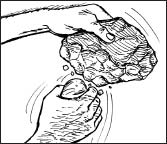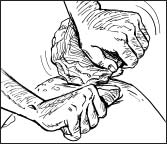The Time Travelers' Handbook (10 page)
Read The Time Travelers' Handbook Online
Authors: Lottie Stride


Suddenly, you hear the sounds of two stones being struck together behind you. You spin around and see a man sitting on the ground. He is chipping away at a large hunk of rock with a smaller rock.

He is making an axe, but when it is finished, it doesn't look like any axe you've seen before. It doesn't even have a handle. He sees you are puzzled and walks toward a small sapling. Holding the axe in the palm of his hand, blade-side out, he hits the sapling at the base. It comes down in one stroke. He picks it up and then uses the edge of the blade to scrape off some bark at the base. He pulls on the bark and it comes off in one long strip, which he says can be used for string or for weaving baskets.
He hands you a chunk of rock that he says is flint, and tells you to try.
Stone Age Step-By-Step
You will need:
⢠a large piece of dark quartz ⢠protective glasses ⢠a few pebbles of different shapes and sizes ⢠a piece of bone or hard wood ⢠a thick leather cloth or a doubled-up towel
1.
First, select the piece of quartz you will be shaping. If possible, get a piece that is already a flattish round or oval shape. If you tap the quartz, and it makes a muffled sound, this means there is a fault inside which will make it weak and difficult to knap, or shape into a stone tool.
2.
Rest your piece of quartz on a thick leather cloth (or towel) on your left knee and steady it with your left hand if you are right handed (the other way if you are left handed).
3.
Use one of your pebbles to strike the longest side of the quartz. Make blows on one side rather than hitting it in the middle. This will make sure you remove some long shards from the edge of the quartz, making it more pointed.

4.
As you knap, don't throw away the flakes that chip off. They can be made into arrowheads and small tools for scraping the flesh away from an animal skin. Be careful, they are very sharp.
5.
Once you have shaped your big piece of quartz so that it looks narrower on one side than the other (this is the chopping side of the axe), you are ready to start making a sharp edge.
6.
With a smaller pebble, continue flaking off long pieces of quartz in the same way as you did beforeâbut this time, use less force, and be especially careful to knap along the long face of the axe.

As the edge of the axe gets thinner, you'll need to use your pieces of bone or wood instead of the pebble to avoid breaking off too much quartz at one time.
7.
Place the axe on a hard surface, and with the chopping side closest to the surface, grind the pointed end of your piece of wood in a twisting motion against the edge of the axe. This will allow you to take off tiny pieces of quartz until your axe is the perfect shape.

Warning
Shards of quartz can be as sharp as kitchen knives. Wear protective glasses and be sure to cover your lap. Be very careful when getting rid of the shards. Wrap them in several sheets of newspaper and throw them in the trash.
Â
Never knap quartz indoors because rock dust can be very bad for your lungs.

The moment you land, you notice your TT handset is flashing. Something is very wrong. A loud siren starts wailing. It's an air raid warning and you need to get to shelter fast. The trouble is you can't see a thing, not even your hand in front of your face. You press the illuminator switch on your TT handset, but right away someone yells, “PUT THAT LIGHT OUT!”
It's 1940, and you've landed in the middle of the Blitz. The Blitz is the name people are giving to a period during World War II when, night after night, German planes dropped bombs on cities all over Britain.
The Blackout
The siren is still blaring and you hear the whistling noise of a bomb dropping to the ground. There is a flash of light and the deafening sound of the explosion. A woman grabs your hand, and pulls you through a door and down some steps. There is light down here and you can see where you are. You're in a London subway station packed with people sheltering from a nighttime bombing raid on the city.
The lady who grabbed you is called Sylvia. Her husband is away fighting. She apologizes for shouting at you, but warns you that you can get in a lot of trouble for showing a light during a blackout. During a blackout, everyone has to cover up his windows with thick black curtains. The street lamps are shaded so they let out only a tiny bit of light, and even car headlights are positioned to point downward and shine through black slits. The government hopes the darkness will make it impossible for the pilots of German bombers to target Britain's cities from the air.
Going Underground
The station is dirty with mice scrambling around. It smells because the toilets are closed and people are having to use buckets, instead. But it is the safest place to be. Sylvia explains that at the beginning of the war, the government banned people from sheltering down here. So, she would just buy a ticket to travel on the subway, and only come up when the all-clear sirens sounded to tell people the bombers had gone. Now more than 200,000 people take cover in stations all over London. There are public shelters, but not enough for everyone, and Sylvia doesn't have a yard in which to build a homemade shelter called an Anderson shelter.


Aboveground, you can still hear the bombs exploding and every so often, the bench you are sitting on shakes. Sylvia is worried about what she will find when the air raid ends. Last week, one family on her street returned from the shelter to find a heap of rubble where their house used to be.
Bombs In The Blitz
Sylvia tells you the German planes overhead are dropping two kinds of bombs:
1.
Fire bombs, known as incendiary bombs. The Germans drop these first, in clusters. The bombs are small, but full of chemicals, and burst into flames wherever they land. They cause lots of damage and create light for the pilots to see where to drop the rest of their bombs.
2.
High-explosive bombsâpacked with explosives. Most of these explode on impact, destroying the buildings around them. Others have timers on them and explode hours later, without any warning. Army bomb disposal experts try to disarm them, but it's dangerous work and many are killed.
Sylvia tells you that last week, on November 14, 1940, German bombers dropped around 500 tons of bombs on the city of Coventry near Birmingham, England. This killed 568 people and injured over 1,000. More than 60,000 buildings were destroyed.
Beating The Blitz Blues
⢠Bring earplugs. If you thought your dad's snoring was bad, an air raid is much worse. The wail of the sirens, the thump of exploding bombs, and the crashing as buildings collapse is terrifying. To keep everyone's spirits up and drown out the sound of the bombs, why not try singing?
⢠Bring something to do. During a raid, you can be in the shelter for a long time. Sylvia is knitting, but you could try a board game, or a pack of cards.
⢠Don't go out after sunset unless you have to. The blackout has caused chaos on the roads. People can't see where they are going. They bump into lampposts, fall off bridges, and cars have crashed into canals.
⢠Bring a snack. Sadly, food is in short supply. The government controls how much food people can haveâthis is called rationing.
⢠Get evacuatedâlots of children have been sent to the countryside to live with families away from the bombs (
see
). Sylvia has two daughters who have been evacuated to Wales.
